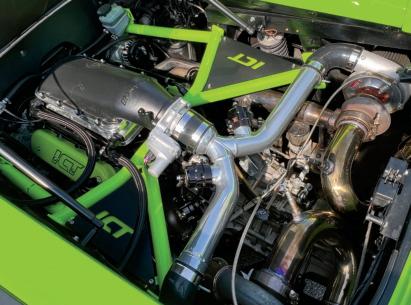
3 minute read
WHENHOTROD WONTHEAMBR
Hot Rod’s vision of the modern street roadster wins in 1963.

Advertisement
❱You know what they say about beauty and the eye of the beholder. To my eye, the angular, asymmetrical XR-6 isn’t a beautiful hot rod. The judges at the Grand National Roadster Show thought differently and awarded the HOT ROD project car the America’s Most Beautiful Roadster trophy in 1963.
The XR-6 (experimental roadster, six-cylinder engine) was the brainchild of Associate Editor LeRoi Smith. As he recalled in the buildup’s first installment (March ’62), he was bench racing with other staffers during a coffee break and pointed out that “the cost of the average rod had risen considerably during the past decade, but hot rod design had failed to keep pace. We were immediately frowned upon by the ‘old heads.’ We stuck to our guns, and the result was our resolve to build a modern street roadster of our own.” The
BY DREW HARDIN PHOTOGRAPHY HOT ROD ARCHIVES
car would incorporate “many of the automotive design and performance advances introduced during the past several years,” but at the same time it would have to be “simple enough for anyone to build” with “no strange and exotic hard-to-duplicate items; it had to be relatively inexpensive, and we must do as much of the work ourselves as possible.”
Smith asked designer Steve Swaja to sketch a body based on a fiberglass ’27 Model T tub with a track nose and an abbreviated ’23 T truck bed. Smith built a rectangular tube frame with a Volkswagen frontend and a trailing link rear suspension holding a Dodge Lancer axle. For power, Smith chose the relatively new Chrysler Slant Six backed by a five-speed Siata gearbox from MotorTrendEditor Chuck Nerpel “that had seen service behind a Ford V8-60 race car.”
When Smith next reported on the car’s progress (June ’62), the Siata box was replaced by the transmission from a ’61 Lancer. Smith did some preliminary fitting work on the fiberglass tub, channeling it 4 inches over the frame. Bonneville racer Tom Beatty machined Triumph TR-3 disc brakes to fit on the VW spindles, while Morris Minor rack-and-pinion steering was fitted with help from Indy car builder Frank Kurtis.
In his next two updates (Oct. ’62, Jan. ’63), Smith hinted that Swaja was dreaming up new ideas for the roadster’s body, though readers wouldn’t see the final form until the Oakland show coverage in May. Until then, Smith covered the sorting out of the chassis, revealing it in its finished form in April.
Among the hot rod heroes who helped with the car at this stage were Frank Airheart, who contributed brakes; and Carroll Shelby, who loaned three Weber carburetors to mount on the intake manifold fabricated by Bobby Barr, builder of the headers for Tommy Ivo’s Wagonmaster dragster.





Readers saw the finished XR-6 in the Oakland show coverage, but it wasn’t until the August issue’s final installment that Smith explained the body’s evolution. Between Swaja’s new ideas and the fact that “doors were deemed an absolute necessity,” the decision was made to build a body in steel rather than using the repro fiberglass. The finished chassis, plus “the basic part of a ’27 Model T body,” were delivered to George Barris, “and the bodywork began.” Once the body panels were shaped by Jack Sutton on his English wheel, the car was painted in Tangerine metalflake (as was the frame, though it was “left coarse for effect”). Tom McMullen, then working at Auto Electric Engineering, wired the car, and Tony Nancy made and upholstered the seats.
Oakland was not the XR-6’s final show stop. Smith wanted to take it to the Miami Custom Auto Fair, but there were a few tweaks to do between the two shows. He took the car to Gene Winfield’s shop for an aluminum nose piece and fenders. The car was also repainted, still in Tangerine but without the metalflake, and Tony Nancy made a new set of seats. In Miami, the XR-6 won the Street Rod Sweepstakes trophy.
While the XR-6 strayed beyond Smith’s original plan for an affordable build, he published a chart in the final story tallying the costs for an “economy version.” If only we had a time machine to take us to 1963, when you could pay $10 for a Model A frame, $10-$50 for a steel Model T body (or $150 for a fiberglass one), $3 for wheels, $50 -$250 for an engine, and so on. At those prices, a build like this could cost, as Smith figured it, between $600 and $1,100.










